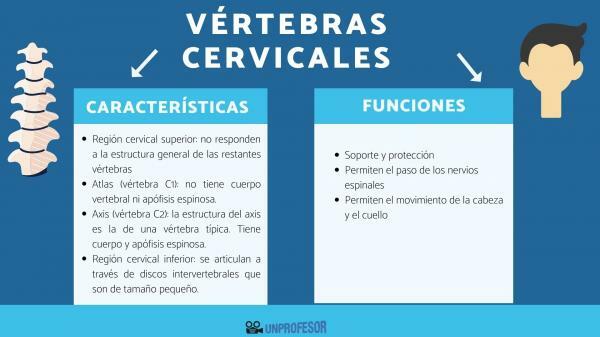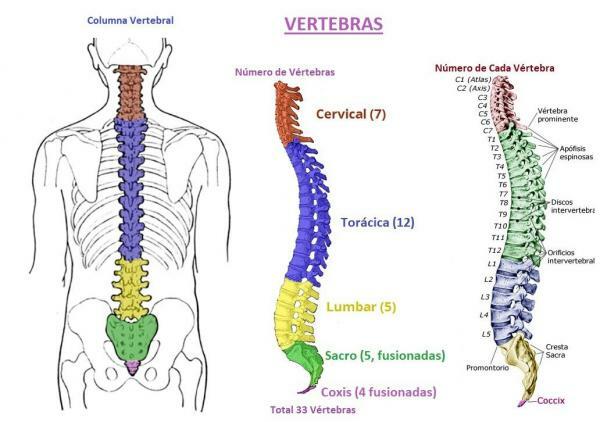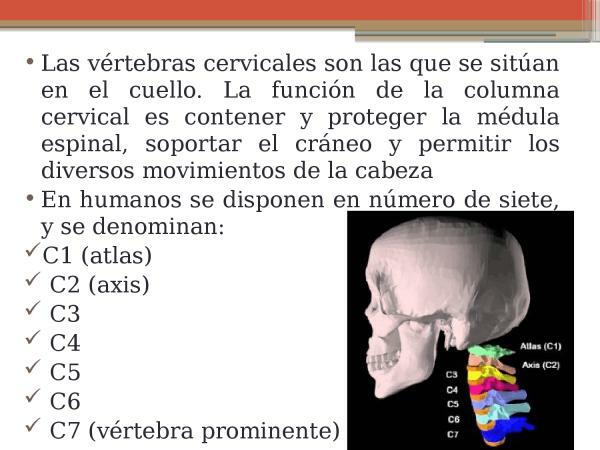CERVICAL vertebrae: characteristics and function

Together, the cervical vertebrae are the ones that make up the cervical spine or cervical region, which is the part of the vertebral column, which corresponds to the neck of vertebrates and which joins the head and the trunk. In this article by a PROFESSOR we will see in detail the cervical vertebrae: their characteristics and functions.
The vertebrae they are a type of irregular bone. That is, they have a complex shape without a defined geometric shape. They consist of spongy bone tissue, covered by a thin layer of compact tissue on the surface.
Parts of the vertebra
- The vertebrae are formed by a vertebral body, located in the anterior (front) area. Attached to the posterior area of the vertebral body, is the so-called vertebral arch, which constitutes the posterior area of the vertebra.
- The vertebral body is made up of highly vascularized spongy bone tissue (supplied by many blood vessels) and covered by a thin layer of compact bone tissue.
- Between the vertebral bodies of two adjacent vertebrae are located intervertebral discs. They are structures made up of two parts: an annulus fibrosus (outer) and a nucleus pulposus (inner pad).
- The posterior wall of the vertebral body and the walls of the vertebral arch form a bone canal where the spinal cord is housed.
- The vertebral arch has different characteristic extensions for the insertion of muscles and tendons, the articulation with adjacent vertebrae or to act as a lever for the muscles to produce movement when they are contract. These extensions are called transverse processes and spinous process.
In humans, the cervical (neck) region is made up of a total of 7 vertebrae. Within the cervical spine two regions are distinguished:
- Upper cervical region: formed by two vertebrae C1 (Atlas) and C2 (Axis). They are called atypical cervicals, since they do not respond to the general structure of the remaining vertebrae that constitute the spine and are not articulated by intervertebral discs, as occurs in the remaining vertebrae of the column.
- Atlas (C1 vertebra): the structure of the atlas is similar to a ring that fits into the base of the skull, at the level of the occipital bone, and articulates with the axis (C2 vertebra) on which it can rotate allowing the head to rotate. This vertebra it is characterized by not having a vertebral body or spinous process. It is made up of two arches, one anterior and one posterior.
- Axis (C2 vertebra): the structure of the axis is that of a typical vertebra. It has a body and a spinous process. However, it has a specific, clearly differentiated structure called tooth or odontoid process, originated from the body of the Atlas. The tooth articulates with the atlas allowing the head to rotate.
- Lower cervical region: formed by 5 vertebrae: C3, C4, C5, C6 and C7. This group of vertebrae have the morphology of a typical vertebra. However, they are smaller vertebrae than the rest of the vertebrae of the spine and their shape is more square. The vertebral bodies of these vertebrae articulate through intervertebral discs that are small in size.

Image: Sciences Area
The cervical vertebrae comply with the functions following:
Support and protection
In the specific case of the vertebrae, their function is to spinal cord protection that is contained in the bony canal formed by the vertebrae when they articulate with each other through the intervertebral discs. In addition, it has the function bear the weight of the skull, thanks to a complex system of tendons, muscles and ligaments that help stabilize the cervical spine. The muscles allow movement of the head while the ligaments prevent excessive movement of the vertebrae that could lead to serious injury.
They allow the passage of spinal nerves
Another function of the cervical vertebrae is that it allows the passage of the spinal nerves. Also called racheid nerves, they are found cconnected to the spinal cord, they exit out of the bone canal through the intervertebral foramen or foramen and are the origin of the nerves of the peripheral nervous system. The nerves of the peripheral nervous system extend throughout the body, up to the organs and the extremities.
In the cervical vertebrae, there are a total of eight pairs of spinal nerves. The spinal nerves in the cervical region are responsible for many of the body's functions and sensory activities. These nerves are primarily skin nerves that collect sensation from part of the head, neck, and upper chest, including the forelimbs (arms and hands).
The intervertebral discs of the cervical vertebrae are relatively small, so it is relatively common for nerve pathologies to occur. associated with the cervical vertebrae, since a slight inflammation of the intervertebral discs can cause impingement of the spinal nerves cervical.
Allow head and neck movement
The two cervical regions are responsible, respectively, for two types of head movement in coordination with muscles and tendons.
- In the case of the upper cervical vertebrae (C1 and C2), they allow the head to rotate at an angle of 90º to each side (right and left).
- Instead, the lower cervical vertebrae (C3 to C7) handle flexion and extension movements of the neck both frontally and laterally.

Image: Docsity
Netter, Frank H. (2019). Atlas of Human Anatomy - 7th Edition Barcelona: Elsevier España, S.L.U.
